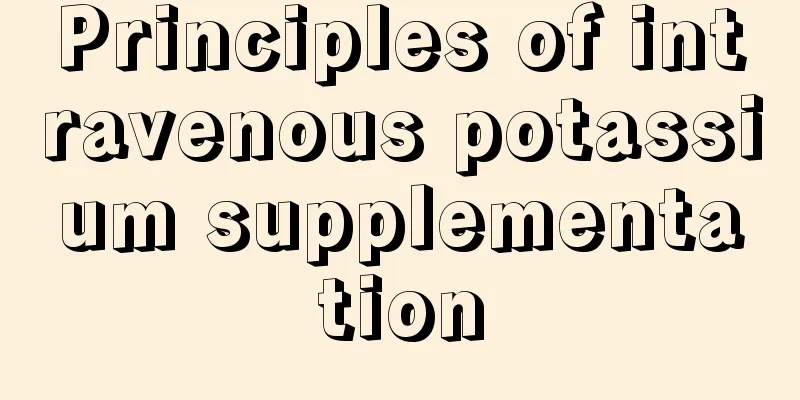Principles of intravenous potassium supplementation

|
Potassium plays a key role in people's physical health, so some people will perform intravenous potassium supplementation in daily life, but intravenous potassium supplementation needs to follow five necessary options. Only in this way can it be guaranteed to be the correct way of intravenous potassium supplementation. Moreover, intravenous potassium supplementation is very painful, and many patients will feel extremely uncomfortable. This needs to be adjusted through some appropriate methods to help relieve the pain. 1. Principles of intravenous potassium supplementation ⑴ Before potassium supplementation, understand the renal function. The urine volume must be above 30-40 ml/h or the daily urine volume must be greater than 500 ml before intravenous potassium supplementation can be performed. ⑵ The dosage of potassium supplement should not be too much. Referring to the serum potassium level, the daily potassium supplement ranges from 40 to 80 mmol, that is, 3 to 6 g of potassium chloride. ⑶ The potassium concentration should not be too high, generally not exceeding 40mmol/L, that is, the potassium chloride content in 1000ml of liquid should not exceed 3g. Direct intravenous injection of high-concentration potassium-containing fluids is strictly prohibited to avoid cardiac arrest. (4) The rate of intravenous potassium supplementation should not be too fast. Generally, the rate is limited to 0.75-1.5g/h. Otherwise, if the potassium supplementation rate is too fast, it may cause an increase in blood potassium for a period of time, resulting in fatal consequences. ⑸ A small number of people with potassium deficiency should receive large doses of potassium intravenously and require bedside ECG monitoring. If the ECG shows changes of hyperkalemia, appropriate measures should be taken immediately. 2. What are the causes of pain during intravenous potassium supplementation? 1. Irritation of the drug itself: Potassium chloride injection is a highly osmotic cationic solution with a pH of 5 and an osmotic pressure of 800 mmol/L. It is a chemical and highly irritating drug. If the potassium ion concentration is too high during intravenous potassium supplementation, K+ will stimulate the nerve fiber cells on the blood vessel wall, causing endothelial cell swelling and vascular spasm, causing pain in the patient. 2. It is related to the individual's pain nerve sensitivity. 3. It is related to the infusion method, including the selection of infusion set, blood vessel, drip speed and time, etc. 4. Potassium ions are pain-causing factors that can cause varying degrees of increases in neurotransmitters in the body, such as adrenaline, 5-hydroxytryptamine and other substances, thereby causing pain at the puncture site. 3. How to reduce the pain of intravenous potassium supplementation? 1. Choose a suitable blood vessel: Choose a thicker blood vessel and avoid repeated punctures in the same vein. If potassium chloride needs to be pumped intravenously, deep vein puncture is the best option. 2. Slow down the drip rate: first check whether the needle is against the blood vessel wall, and then slow down. The intravenous drip rate for adults should not exceed 60 drops/min. It should not be too fast. The drip rate should not exceed 1 gram of potassium chloride per hour, otherwise it may cause cardiac arrest. 3. Solvent selection: Using normal saline or saline as a solvent to supplement potassium can significantly reduce the occurrence of pain. 4. Precision filtration infusion set: Using a fine filtration infusion set with a pore size less than 3µm, there is no need to slow down the drip rate, and the pain relief effect is still up to 80%. 5. Psychological intervention: divert the patient's attention and reduce psychological pressure. 6. Flip the bevel of the needle tip: lift the limb receiving the infusion, adjust the needle handle so that the bevel of the needle tip faces downward (after successful intravenous puncture, flip the needle 180°, that is, turn the needle from the bevel upward to the bevel downward). This can also reduce the irritation of the drug solution to the blood vessel wall and relieve pain. 7. 50% magnesium sulfate wet compress: Soak the gauze, wring it dry (without dripping water), and apply it directly 5 to 6 cm above the puncture point, and wrap it with plastic wrap. 8. Apply wet compress with a warm towel: Apply wet compress along the direction of the blood vessels with a warm towel. 9. Hydrocolloid dressing: Using hydrocolloid dressing instead of transparent dressing to fix the indwelling needle, or applying a hydrocolloid transparent patch above the indwelling needle along the direction of the vein, can prevent phlebitis and relieve pain. 10. External application of potato slices: Potatoes contain solanine, which can excite smooth muscles. They are also rich in vitamin B1 and vitamin B2, which can protect the skin from inflammation, maintain the function of the nervous system and have anti-neuritis effects. Therefore, you can wash fresh potatoes, cut them into thin slices, cover the puncture points, and change them as they dry to prevent phlebitis and relieve pain. 11. Apply polysulfate mucopolysaccharide cream (Hirudoid): Hirudoid has anti-inflammatory effects by inhibiting various enzymes involved in catabolism and affecting prostaglandins and complement systems. You can apply Hirudoid on top of the blood vessels along the direction of the blood vessels and gently massage until absorbed. |
>>: Methods for stopping venous bleeding
Recommend
Kidney cancer puncture examination technique
Even if a blood test detects cancer risks, it doe...
Important Basis of Traditional Chinese Medicine Dialectical Treatment of Prostate Cancer
Traditional Chinese medicine is used in the entir...
Hemorrhoids and blood clots in stool
It is said that "nine out of ten people have...
What kind of chemotherapy drug is best for breast cancer metastasis to the lungs
What chemotherapy drugs are best for breast cance...
What should I do if I have been bloating recently?
With the advancement of science, the variety of f...
Can skin cancer biopsy detect malignant skin lesions in the first place? How to treat skin cancer?
Early skin cancer is not very serious, and patien...
How to treat viral herpes
Viral herpes is a skin disease caused by viral he...
What to do if the fan doesn't cool you down
Electric fans are common household appliances. In...
What causes lower abdominal pain after exercise
Many people will find obvious lower abdominal pai...
Can creatinine be lowered?
Many people will become very worried after measur...
How to treat chronic nephritis proteinuria with traditional Chinese medicine
When it comes to proteinuria, everyone will say t...
What materials are dentures made of?
With the continuous improvement of living standar...
Is lung cancer and throat cancer contagious?
Many people view cancer as an infectious disease,...
This is how you can repair chickenpox scars
I believe that many people have had chickenpox wh...
Which type of cataract lens is better
When cataract patients undergo surgical treatment...









